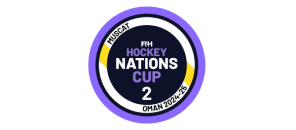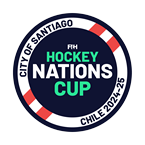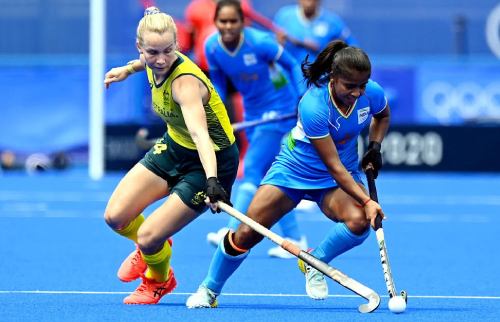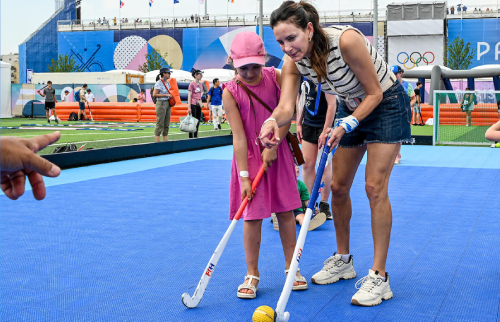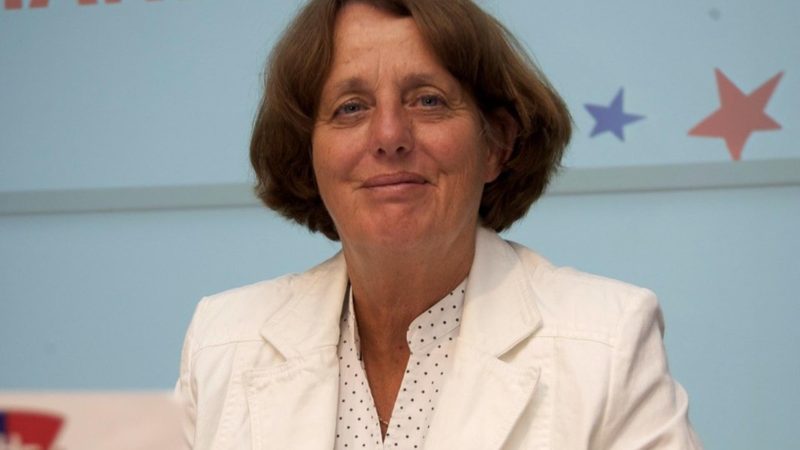
Courtesy of EHF
‘We are our most powerful when we work together’. That is the message that comes loud and clear from talking to Marijke Fleuren following the publication of the Report ‘Towards more gender equality in sport’ from the High Level Group on Gender Equality in Sport (2022).
The High-Level Group (HLG) was set up with one main aim: to achieve a more equitable gender balance in sport overall. It was established by Commissioner Mariya Gabriel in 2020 and has 15 representatives from across the world of sport, including government bodies, non-governmental organisations and sports federations. Its recommendations and action plan apply to the EU Member States, national and international sports bodies and local and grass roots level organisations.
Fleuren is a well-known and highly regarded advocate for gender equality through her work on the IOC Women in Sport Commission and the FIH Women in Sport Committee. In addition, Fleuren is leading the EHF’s work on gender balance in the Board rooms and on coaching programmes of the EHF’s Member National Associations. All the NA’s signed an Equally Amazing Charter in 2019, stating what each of them plans to do over the coming years on gender balance.
Within the HLG, Fleuren’s work with FIH and EHF meant she was one of the people on the group who had ‘walked the walk,’ and had working instances of how gender equality policies could be implemented. This insight was vital for her to bring to the group’s thinking.
‘I tried to bring into the HLG the experiences we have had in hockey and also from SWinG (Supporting Women in achieving their Goals), because we have got some fantastic insights into leadership, particularly from SWinG. Unfortunately, these ideas didn’t all get taken up because we still need to see research to show they are effective.
‘What I consider as an important result of the report is the list with transversal subjects next to the main areas where gender equality must come up to speed. It is good to see budget and communications alongside participation and leadership, as these are all important areas within gender equality. To come forward with good recommendations, the group experienced a wide range of presentations from inside and outside the sport. We had a very good presentation from the European Broadcasting Union (EBU) for example.’
In a fact-sheet produced by the High Level Group on Gender Equality in Sport, the gender disparities are made abundantly clear: participation, coaching and officiating, leadership, media coverage and pay levels/contracts – these are all areas in which gender gaps remain. In addition to these five areas of concern is the worrying fact that gender-based violence – physical, sexual and psychological – is still, shockingly, still experienced by women to a far greater degree than by men.
However, change is afoot and there have been some significant steps forward. Examples include the fact that principles of gender equality are firmly enshrined in any action funded by Erasmus+ Sport. Awareness is rising through studies and discussions within the Commission Expert Group on Good Governance. Initiatives such as the #BeInclusive EU sports Awards recognise the work of sports that use activity to increase social inclusion.
As mentioned, within the HLG report there are eight transversal topics that any organisation should consider when developing an action plan to address gender equality.
The first of these is the importance of putting a gender perspective at the forefront of any policies or strategies. All stakeholders within an organisation should ensure a gender perspective is at the core of their actions.
Why there are gender inequalities within a sport or an organisation is usually very complex. For this reason, an intersectional approach is necessary when finding solutions. Overlapping causes can only be addressed by an open approach and working together.
When it comes to achieving gender equality, there must be practical measures in place. Budget that is dedicated to addressing gender equality; coordinators, or people with the responsibility to make sure that the action plan is being delivered are essential – there must be ownership of the policy for it to succeed; research and evaluation to ensure progress is being made and targets are being met.
Then there is the outward-looking approach. Education that explains why equality is necessary, whether that is addressing children within clubs and schools or talking to stakeholders about the importance of equality within the organisation. How the messaging is then communicated is important. It must be clear and appropriate for the audience.
Finally, there is the importance of getting support from men within the organisation. If men are wholly supportive of a gender equality action plan and policy, then they can be at the heart of creating change.
This is the topic that Fleuren thinks is sometimes misunderstood: ‘Instead of being an ‘us and them’ situation, we should be using their support in a constructive way. The United Nations ‘He for She’, campaign was a good illustration of this.’
The HLG report highlights and provides examples of the tremendous amount of work that is being done across the continent addressing many of the themes.
When it comes to participation there have been some really innovative and successful projects. These range from the She Run’s Active Girl’s Lead Erasmus + project, run by the International School Sports Federation, which encouraged 2,000 15-18 year old girls from 35 countries to engage in physical activity, to the activity of LEAP Sport in Scotland which has provided a range of resources for the sports sector to educate and raise awareness of transgender people in sport.
Within coach development, international sports bodies such as World Rugby, national federations such as the Norwegian Ski Federation and organisations such as the University of Hertfordshire have all put programmes in place to develop female coach eduction opportunities.
For Fleuren, the inclusion of grass roots, local sports providers in the process is absolutely vital as these are the people who deliver sports on the ground. ‘You would expect things to be passed down from the international federation to the national associations and then to the grass roots, but all too often, this is still not happening. It is why you need dedicated people to deliver gender equality measures.
‘Our next piece of work [at EHF] is to get stakeholders into the clubs. Our ‘Equally Amazing’ project is working at national and international level. Within our EHF structure I know that already many dedicated women and men are working on gender equality into their own countries. Clubs will be our next goal.
This report shows us other ways and new ideas that can be introduced to make it happen.’
Leadership is a vitally important part of achieving gender equality. For a young women looking for a pathway, there is nothing as inspirational as someone already breaking through into leadership roles. The European Hockey Federation, the Women’s Sport Trust, World Rowing, the International Basketball Federation (FIBA) and a host of other sports bodies all run courses designed to empower women to take up leadership roles.
‘It might sound like a simplistic approach,’ says Fleuren, ‘but it isn’t. The importance of role models, of seeing someone like yourself, is vital if people from less represented groups are ever to become leaders.’
With pay gaps, questions over maternity leave as an athlete and the dark cloud of physical, sexual and mental abuse within the world of elite sport, there remain huge issues to be addressed. HLG has finished its remit with the publication of the report but Fleuren’s hope is that the report itself will serve as a springboard for more change.
‘In our own small way we are trying to inspire people and give them ideas that they can use to make a difference in their own sporting environment,’ says Fleuren, adding, ‘Gender equality is not a paragraph or a chapter; it needs to be part of the whole story.’

